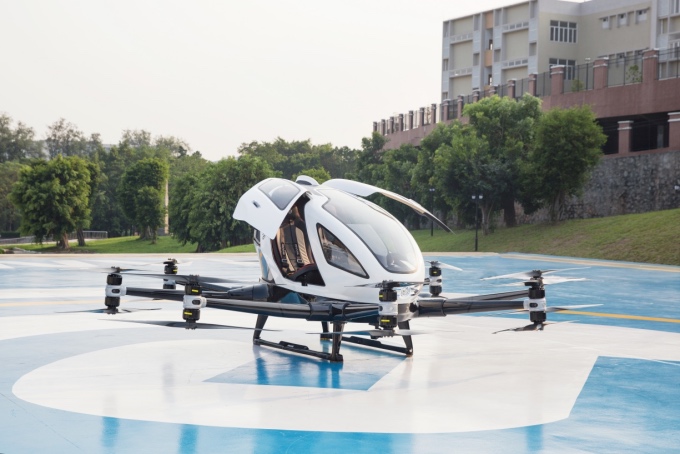On July 20, Hu Huazhi (胡华智) , the founder, chairman, and CEO of EHang, a pioneer in autonomous air mobility technology, was the first Chinese honouree for his achievements in the aviation industry at the Living Legends of Aviation Awards Europe in St. Wolfgang, Austria. We spoke with Huaxiang (Edward) Xu (徐华翔) , the company’s newly appointed chief strategy officer, who was previously head of Asia transportation research at Morgan Stanley Asia.
When was EHang founded and how many people does the company employ? Does EHang have its own factories, or does it work with industry partners?
Edward Xu: EHang was founded in 2014 and now has over 200 employees. We have our own production line in Guangzhou, China, but we also launched a partnership with FACC, a leading aviation manufacturer based in Austria. Based on our current plan, FACC will take EHang’s autonomous aerial vehicles (AAVs) to mass production in Austria by 2020.
China is a pioneer in the drone industry and DJI is a global leader in consumer drones. In terms of passenger drones, EHang is the first company that signed a partnership, in February 2017, with a city authority, Dubai Roads and Transport Authority, to jointly promote and introduce the EHang 184 autonomous aerial vehicle in Dubai. How do you explain China’s technological advances?
Edward Xu: We do appreciate the concrete progresses made by Chinese firms in recent years in specific fields. In early 2019, the Civil Aviation Administration of China (CAAC) issued a Guidance on UAV Airworthiness Certification Based on Operational Risks, setting a milestone for AAV commercialization and the UAM industry. Meanwhile, CAAC also authorized EHang to be China’s first company to run passenger AAV test programmes.
The CAAC and EHang plan to work together to develop unmanned aerial vehicle (UAV) programmes. Some of these initiatives include the establishment of airworthiness standards and certification methods for transporting cargo, inspecting powerlines, and carrying passengers with UAVs.
Our mission is to make safe, autonomous, and eco-friendly air mobility accessible to everyone and to seek cost-efficient solutions for many of the challenges of urban life through our AAV platform. AAVs can be highly versatile in various areas, by saving travelling time, reducing pollution, fulfilling emergency needs, and enhancing efficiency.
The use of UAVs in logistics seems to be the first area to take off. In May 2018, EHang was approved to operate the first urban drone delivery route in China. In June 2018, the company partnered with the grocery store YH Super Species to launch their Guangzhou flagship store with drone deliveries: a first in China. Also, last May, DHL-Sinotrans signed a strategic partnership with EHang to launch a fully-automated and intelligent drone delivery service in China. Can you explain these partnerships and the implications they have on the Chinese market and elsewhere?
Edward Xu: In addition to passenger transportation, AAV logistics is one of our key focus areas. Currently, AAV/UAV logistics focus on last-mile delivery, emergency, and offshore cargo delivery. We gained experiences and collected data by working with partners in the retail and express segments to test a business model for our last-mile delivery partners. We will also work with the CAAC to improve regulations and establish standards for AAV/UAV logistics.
Overall, we are a provider of smart drone delivery solutions and aim to empower our customers and partners in the logistics industry.
In November 2018, EHang entered into a strategic partnership with the Austrian aerospace group FACC to jointly develop UAMs, such as air taxis. Can you explain this partnership? Does this mean that EHang drones will be manufactured in Austrian FACC factories?
Edward Xu: Our goal is to optimize EHang AAVs and take them to mass production by 2020. This partnership will ensure the deliveries of our EHang AAVs in Europe with the necessary local support.
When does EHang see the passenger drone market taking off? Will it happen in China?
Edward Xu: We think it may happen sooner than we can imagine. We will actively work with partners in multiple industries around the world to be part of the vanguard of this development. During EHang’s European AAV premiere in Vienna in April, Norber Hofer, Austria’s minister for Transportation, Innovation, and Technology, said that “it is very realistic that air taxis will be in the sky in Austria by 2025” and that “their development is very rapid and technical; they already work great.”
During the last World Economic Forum held at the beginning of July in Dalian, China, Derrick Xiong, co-founder of EHang, said that according to a new paper published by Morgan Stanley, the UAM market is expected to be worth approximately $1.5 trillion by 2040. What will be the most dynamic segment, will it be consumers, logistics, or passenger UAVs?
Edward Xu: Relative to consumer drones, we see much bigger market potential for logistics and passenger drones. Specifically, we believe AAV/UAV logistics will be a more realistic area for applications. However, we think passenger AAVs will have the most potential.
It has been said that the technology used on EHang drones is 100% Chinese, but what about the materials? What is the proportion of carbon fibre or other composite materials in EHang’s UAVs, and do the materials come from Chinese producers?
Edward Xu: We are proud to say that most composite materials used in EHang AAVs are sourced from Chinese suppliers.
Many aerospace and tech giants – such as Airbus, Boeing, Uber, Alibaba and Amazon – have strong ambitions in the drone market. How does EHang plan to continue to navigate this increasingly saturated environment successfully?
Edward Xu: First, we think this is a new industry far from “saturated”. Despite various players in the industry, we don’t see any concrete products or services launched so far. For EHang, we will continue to do well with our own products.
Specifically, we will focus on the following: further enhance our technological leadership; bolster our development and manufacturing capabilities; expand our AAV portfolio and strengthen our platforms; expedite commercialization; and seek strategic partnerships in both production and technology.
A question about the EHang projects in Lyon, France, where the company opened a research and development centre at the end of 2018, went unanswered.
This article has been commissioned and published by JEC Group in JEC Composites Magazine n°131





